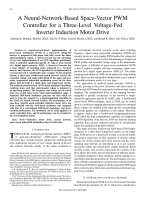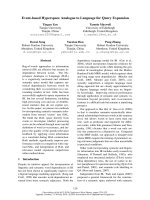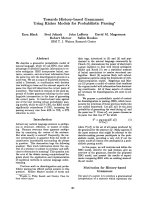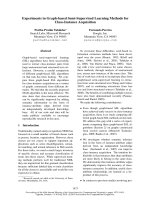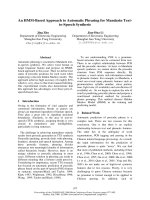Context based bit plane golomb coder for scalable image coding
Bạn đang xem bản rút gọn của tài liệu. Xem và tải ngay bản đầy đủ của tài liệu tại đây (2.09 MB, 105 trang )
CONTEXT-BASED BIT PLANE GOLOMB CODER
FOR SCALABLE IMAGE CODING
ZHANG RONG
(B.E. (Hons.) USTC, PRC)
A THESIS SUBMITTED
FOR THE DEGREE OF MASTER OF ENGINEERING
DEPARTMENT OF ELECTRICAL AND COMPUTER
ENGINEERING
NATIONAL UNIVERSITY OF SINGAPORE
2005
i
ACKNOWLEDGEMENTS
I would like to express my sincere appreciation to my supervisors, Prof. Lawrence
Wong and Dr. Qibin Sun, for their constant guidance, encouragement and support
during my graduate studies. Their knowledge, insight and kindness provided me
lots of benefits.
I want to take this opportunity to thank Yu Rongshan for his thoughtful
comments, academic advices and encouragement on my research. I have also
benefited a lot from intersections with He Dajun, Zhou Zhicheng, Zhang Zhishou,
Ye Shuiming, Li Zhi, researchers in the Pervasive Media Lab. Their valuable
suggestions on my research and thesis are highly appreciated. Special thanks to
Tran Quoc Long and Jia Yuting for the valuable discussions and help on both my
courses and research. I also want to thank my officemates Lao Weilun, Wang Yang
and Moritz Häberle for their friendship and support on my studies. In addition, I
would like to thank my friends Zhu Xinglei, Li Rui and Niu Zhengyu for their
friendship and help on my studies and daily life.
I am so grateful to Wei Zhang, my husband, for his love and encouragement
during our years. His broad knowledge on engineering and computer science helps
me a lot in my research, and his love encourages me to pursue my dreams. I also
want to thank my parents for their love and years of nurturing and supporting my
education. Thank Mum for her care, her guidance towards my studies. And thank
Dad for his constant encouragement during my life.
i
LIST OF PUBLICATIONS
1.
Rong Zhang, Rongshan Yu, Qibin Sun, Wai-Choong Wong, “A new bit-plane
entropy coder for scalable image coding”, IEEE Int. Conf. Multimedia &
Expo, 2005.
2.
Rong Zhang, Qibin Sun, Wai-Choong Wong, “A BPGC-based scalable image
entropy coder resilient to errors”, IEEE Int. Conf. Image Processing, 2005.
3.
Rong Zhang, Qibin Sun, Wai-Choong Wong, “An efficient context based
BPGC scalable image coder”, IEEE Trans. on Circuit and Systems II,
(submitted).
ii
TABLE OF CONTENTS
ACKNOWLEDGEMENTS......................................................................................i
LIST OF PUBLICATIONS......................................................................................ii
TABLE OF CONTENTS ....................................................................................... iii
SUMMARY ............................................................................................................vi
LIST OF TABLES ............................................................................................... viii
LIST OF FIGURES ................................................................................................ix
Chapter 1.
1.1.
INTRODUCTION ..............................................................................1
Background ............................................................................................1
1.1.1.
A general image compression system ..........................................1
1.1.2.
Image transmission over noisy channels......................................3
1.2.
Motivation and objective........................................................................4
1.3.
Organization of the thesis.......................................................................5
Chapter 2.
WAVELET-BASED SCALABLE IMAGE CODING........................7
2.1.
Scalability...............................................................................................7
2.2.
Wavelet transform ..................................................................................9
2.3.
Quantization .........................................................................................14
2.3.1.
Rate distortion theory.................................................................14
2.3.2.
Scalar quantization.....................................................................16
2.4.
Bit plane coding....................................................................................18
2.5.
Entropy coding .....................................................................................19
iii
2.5.1.
Entropy and compression...........................................................20
2.5.2.
Arithmetic coding ......................................................................21
2.6.
Scalable image coding examples..........................................................23
2.6.1.
EZW...........................................................................................23
2.6.2.
SPIHT ........................................................................................26
2.6.3.
EBCOT ......................................................................................28
2.7.
JPEG2000.............................................................................................33
Chapter 3.
3.1.
CONTEXT-BASED BIT PLANE GOLOMB CODING..................36
Bit Plane Golomb Coding ....................................................................36
3.1.1.
BPGC Algorithm........................................................................37
3.1.2.
BPGC used in AAZ....................................................................40
3.1.3.
Using BPGC in scalable image coding......................................42
3.2.
Context modeling .................................................................................44
3.2.1.
Distance to lazy bit plane...........................................................44
3.2.2.
Neighborhood significant states.................................................46
3.3.
Context-based Bit Plane Golomb Coding ............................................49
3.4.
Experimental results .............................................................................54
3.4.1.
Lossless coding ..........................................................................55
3.4.2.
Lossy coding ..............................................................................60
3.4.3.
Complexity analysis...................................................................64
3.5.
Chapter 4.
Discussion ............................................................................................66
ERROR RESILIENCE FOR IMAGE TRANSMISSION ................69
iv
4.1.
Error resilience overview .....................................................................69
4.1.1.
Resynchronization......................................................................70
4.1.2.
Variable length coding algorithms resilient to errors.................72
4.1.3.
Error correction..........................................................................73
4.2.
Error resilience of JPEG2000...............................................................74
4.3.
CB-BPGC error resilience....................................................................78
4.3.1.
Synchronization .........................................................................78
4.3.2.
Bit plane partial decoding ..........................................................79
4.4.
Experimental results .............................................................................82
4.5.
Discussion ............................................................................................86
Chapter 5.
CONCLUSION.................................................................................87
BIBLIOGRAPHY..................................................................................................89
v
SUMMARY
With the increasing use of digital images and delivering those images over
networks, scalable image compression becomes a very important technique. It not
only saves storage space and network transmission bandwidth, but also provides
rich functionalities such as resolution scalability, fidelity scalability and
progressive transmission. Wavelet based image coding schemes such as the
state-of-the-art image compression standard JPEG2000 are very attractive for
scalable image coding.
In this thesis, we present the proposed wavelet-based coder, Context-based Bit
Plane Golomb Coding (CB-BPGC) for scalable image coding. The basic idea of
CB-BPGC is to combine Bit Plane Golomb Coding (BPGC), a low complexity
embedded compression strategy for Laplacian distributed sources such as wavelet
coefficients in HL, LH and HH subbands, with image context modeling
techniques. Compared to the standard JPEG2000, CB-BPGC provides better
lossless compression ratio and comparable lossy coding performance by exploring
the characteristics of the wavelet coefficients. Fortunately, compression
performance improvement is achieved together with lower complexity in
CB-BPGC compared to JPEG2000.
The error resilience performance of CB-BPGC is also evaluated in this thesis.
Compared to JPEG2000, CB-BPGC is more resilient to channel errors when
simulated on the wireless Rayleigh fading channel. Both the Peak Signal-to-Noise
vi
Ratio (PSNR) and the subjective performance of the corrupted images are better
than those of JPEG2000.
vii
LIST OF TABLES
Table 2-1 An example of bit plane coding ......................................................18
Table 2-2 Example: fixed model for alphabet {a, e, o, !}...............................21
Table 3-1 D2L contexts...................................................................................45
Table 3-2 D2L context bit plane coding examples..........................................46
Table 3-3 Contexts for the significant coding pass (if a coefficient is significant,
it is given a 1 value for the creation of the context, otherwise a 0 value;
- means do not care)..........................................................................48
Table 3-4 Contexts for the magnitude refinement pass...................................48
Table 3-5 Comparison of the lossless compression performance for 5 level
wavelet decomposition of the reversible 5/3 LeGall DWT between
JPEG2000 and CB-BPGC (bit per pixel)..........................................57
Table 3-6 Comparison of the lossless compression performance for 5 level
wavelet decomposition of the irreversible 9/7 Daubechies DWT
between JPEG2000 and CB-BPGC (bit per pixel) ...........................58
Table 3-7 Image Cafe (512×640) block coding performance, resolution level
0~4, 31 code blocks (5 level wavelet reversible decomposition, block
size 64×64) ........................................................................................59
Table 3-8 Comparison of lossless coding performance (reversible 5 level
decomposition, block size 64×64) of JPEG2000, JPEG2000 with lazy
coding and CB-BPGC.......................................................................60
Table 3-9 Average run-time (ms) comparisons for image lena and baboon
(JPEG2000 Java implementation JJ2000 [11] and Java
implementation of CB-BPGC)..........................................................64
viii
LIST OF FIGURES
Figure 1-1 Block diagram of image compression system.................................2
Figure 1-2 Image encoding, decoding and transmission over noisy channels..3
Figure 2-1 Comparison of time-frequency analysis of STFT (left) and DWT
(right), each rectangle in the graphics represents a transform
coefficient. .....................................................................................10
Figure 2-2 Comparison of sine wave (left) and Daubechies_10 wavelet (right)
........................................................................................................10
Figure 2-3 Wavelet decomposition of an N×M image, vertical filtering first and
horizontal filtering second .............................................................12
Figure 2-4 Wavelet decomposition (a) One level; (b) Two levels; (c) Three
levels ..............................................................................................12
Figure 2-5 (a) Image lena (512×512), (b) 3-level wavelet decomposition of
image lena (the wavelet coefficients are shown in gray scale image,
range [-127, 127]) ..........................................................................13
Figure 2-6 Rate distortion curve .....................................................................15
Figure 2-7 (a) A midrise quantizer; (b) A midtread quantizer.........................16
Figure 2-8 Uniform scalar quantization with a 2∆ wide dead-zone ...............17
Figure 2-9 Representation of the arithmetic coding process with interval at each
stage ...............................................................................................22
Figure 2-10 (a) EZW parent-child relationship; (b) SPIHT parent-child
relationship.....................................................................................24
Figure 2-11 Partitioning image lena (256×256) to code blocks (16×16)........29
Figure 2-12 EBCOT Tier 1 and Tier 2 ............................................................30
Figure 2-13 EBCOT bit plane coding and scanning order within a bit plane.30
Figure 2-14 Convex hull formed by the feasible truncation points for block Bi
........................................................................................................32
Figure 2-15 Code block contributions to quality layers (6 blocks and 3 layers)
........................................................................................................33
ix
Figure 2-16 Image encoding, transmission and decoding of JPEG2000 ........33
Figure 2-17 JPEG2000 code stream ...............................................................34
Figure 3-1 Bit plane approximate probability Qj example .............................39
Figure 3-2 Structure of AAZ encoder .............................................................41
Figure 3-3 Histogram of wavelet coefficients in (a) HL2 subband; (b) LH3
subband ..........................................................................................42
Figure 3-4 Eight neighbors for the current wavelet coefficient ......................46
Figure 3-5 Context based BPGC encoding a code block................................50
Figure 3-6 Example of three types of SIG code blocks with size 64×64 (the first
row, coefficients range [-127, 127], white color represents positive
large magnitude data and black color indicates negative large
magnitude.) and their corresponding subm matrixes (8×8) (the
second row): (a) smooth block, σ = 0.4869; (b) texture-like block, σ
= 1.3330; (c) block with edge, σ = 2.2537.....................................53
Figure 3-7 Example of two types of LOWE code blocks with size 64×64 (the
first row, coefficients range [-63, 63], white color represents positive
large magnitude data and black color indicates negative large
magnitude.) and their corresponding subm matrixes (8×8) (the
second row): (a) smooth block, σ = 0.9063; (b) texture-like block, σ
= 1.7090 .........................................................................................54
Figure 3-8 Lossy compression performance...................................................62
Figure 3-9 Histogram of coefficients in the LL subband of image lena 512×512
(top) and image peppers 512×512 (down) (Daubechies 9/7 filter, 3
level decomposition)......................................................................63
Figure 4-1 Corrupted images by channel BER 3×10-4(left: encoded by DCT
8×8 block; right: Daubechies 9/7 DWT, block size 64×64)...........70
Figure 4-2 JPEG2000 Segment marker for each bit plane .............................77
Figure 4-3 CB-BPGC segment markers for bit planes ...................................78
Figure 4-4 CB-BPGC partial decoding for non-lazy bit planes (coding pass 1:
significant propagation coding pass; coding pass 2: magnitude
refinement coding pass; coding pass 3: clear up coding pass. “x”
means error corruption.).................................................................80
x
Figure 4-5 CB-BPGC partial decoding for lazy bit planes (coding pass 1:
significant propagation coding pass; coding pass 2: magnitude
refinement coding pass. “x” means error corruption.)...................81
Figure 4-6 Comparison of error resilience performance between JPEG2000
(solid lines) and CB-BPGC (dashed lines) at channel BER 10-4, 10-3,
and 6×10-3.......................................................................................82
Figure 4-7 PSNR comparison for channel error free and channel BER at 10-3
for image lena 512×512 (left) and tools 1280×1024 (right) ..........83
Figure 4-8 Subjective results of image lena (a~c), bike (d~f), peppers (g~i),
actors (j~l), goldhill (m~o) and woman (p~r) at bit rate 1 bpp and
channel BER 10-3 ...........................................................................85
xi
Chapter 1. INTRODUCTION
With the expanding use of modern multimedia applications, the number of digital
images is growing rapidly. Since the data used to represent images can be very
large, image compression is one of the indispensable techniques to deal with the
expansion of image data. Aiming to represent the images using as few bits as
possible while satisfying certain quality requirement, image compression plays an
important role in saving channel bandwidth in communication and also storage
space for digital image data.
1.1. Background
Image compression has been a popular research topic for many years. The two
fundamental components of image compression are redundancy reduction and
irrelevancy reduction. Redundancy reduction refers to removing the statistical
correlations of the source, by which the original signals can be exactly
reconstructed; irrelevancy reduction aims to omit less important parts of the signal,
by which the reconstructed signal is not exactly the original one but without
bringing visual loss.
1.1.1. A general image compression system
A general image encoding and decoding system is illustrated in Figure 1-1. As
shown in the figure, the encoding part includes three closely connected
1
components, the transform, the quantizer and the encoder while the decoding part
consists of the inverse ones, the decoder, the dequantizer and the inverse
transform.
Figure 1-1 Block diagram of image compression system
Generally, images are never directly raw bits compressed by coding algorithms
and image coding is much more than general purpose compression methods. This
is because in most images, which are always represented by a two-dimensional
array of intensity values, the intensity values of the neighboring pixels are heavily
correlated. The transform in the image compression system is applied to remove
these correlations. It can be Linear Prediction, Discrete Fourier Transform (DFT),
Discrete Cosine Transform (DCT), Discrete Wavelet Transform (DWT) or others,
each with its own advantages and disadvantages. After the transformation, the
transformed data which is more compressible is further quantized into a finite set
of values. Finally, the entropy coder is applied to remove the redundancy of the
quantized data. The decoding part of the image compression system is the inverse
process of the encoding part. It is usually of lower complexity and performs faster
than the encoding part.
According to the reconstructed images, image compression schemes can be
classified into two types, lossless coding and lossy coding. Lossless coding
2
methods encode the images only by redundancy reduction where we can
reconstruct exactly the same images as the original ones, but with a moderate
compression performance. Lossy coding schemes, which use both redundancy and
irrelevancy reduction techniques, achieve much higher compression while
suffering some image quality degradation compared to the original images.
However, if the lossy coding algorithms do not target at very high compression
ratio, reconstructed images with no significantly visible loss can be achieved,
which is also called perceptual lossless coding.
1.1.2. Image transmission over noisy channels
As more and more multimedia sources are distributed over the Internet and
wireless mobile networks, robust transmission of these compressed data has
become an increasingly important requirement since these channels are
error-prone. Figure 1-2 shows the process of image encoding, decoding and
transmission over adverse channels. The challenge of robust transmission is to
protect the compressed data against adverse channel conditions while reducing the
impact on bandwidth efficiency, a process called error resilient techniques.
Figure 1-2 Image encoding, decoding and transmission over noisy channels
The error resilient techniques can be set up at the source coding level, the
3
channel coding level or both. Resynchronizaiton tools, such as segmentation and
packetization of the bitstreams are often used to ensure independent decoding of
the coruppted data and thus prevent error propagation. Self-recovery coding
algorithms can also be included, such as reversible various length codes (RVLC),
with which we can apply backward decoding to continue reconstructing the
images when error is detected in the forward decoding process.
Additionally, channel coding techniques such as forward error correction (FEC)
can be used to detect and further possibly correct errors without requesting
retransimission of the original bitstreams. In some applications, if retransmission
is possible, automatic repeat request (ARQ) protocols can be used to request
retransimission of the lost data.
Except for the above techniques which are responsible for protecting the
bitstream against noise, there are also some other error recovery ways, such as
error concealment based on interpolation or edge filter methods to conceal errors
in the damaged images in a post processing way.
1.2. Motivation and objective
With the ever-growing requirements from various applications, compression ratio
is no longer the only concern in image coding. Some other features such as low
computational complexity, resolution scalability, distortion scalability, region of
interest, random access, and error resilience are also required by some
applications. The international image compression standard JPEG2000, which
4
applies several state-of-the-art techniques, specifies such an attractive image coder
which provides not only superior rate-distortion, subjective image quality but also
rich functionalities.
However, behind the attractive features of JPEG2000 is the increase in
computational complexity. As lower complexity coder is more practical than the
increase in compression ratio for some applications [5], it is desirable to develop
certain new image coders which achieve comparable coding performance as the
current standard and provide rich functionalities but have lower complexity.
Based on an efficient and low complexity coding scheme, Bit Plane Golomb
Coding (BPGC) developed for Laplacian distributed signals which is now
successfully applied in scalable audio coding, we study the feasibility of this
algorithm in scalable image coding. By exploring the distribution characteristics
of the wavelet coefficients in the coding algorithm, we aim to develop a new
image entropy coder which provides comparative coding performance and also
rich features as the standard JPEG2000 but with lower complexity. Additionally,
we also intend to improve the error resilience performance of the new image coder
compared to that of JPEG2000 operating in a wireless Rayleigh fading channel
1.3. Organization of the thesis
This thesis is organized as follows. We briefly review some related techniques in
wavelet based scalable image coding in Chapter 2, such as wavelet transform,
quantization, bit plane coding, entropy coding and some well-known scalable
5
image coding examples.
In Chapter 3, we first review the embedded coding strategy, BPGC and then
introduce the proposed Context-based Bit-Plane Golomb Coding (CB-BPGC) for
scalable image coding. Comparison of both the PSNR and visually subjective
performance between the proposed coder and the standard JPEG2000 are
presented in this chapter. We also include a complexity analysis of CB-BPGC at
the end of this chapter.
A brief review of error resilience techniques is given in Chapter 4, followed by
the error resilience strategies used in CB-BPGC. In this chapter, we also show the
experimental results of the error resilience performance of the two coders.
Chapter 5 then gives the concluding remarks of this thesis.
6
Chapter 2. WAVELET-BASED
SCALABLE
IMAGE
CODING
As the requirement of progressive image transmission over the Internet and
mobile networks increases, scalability becomes a more and more important
feature for image compression systems. Wavelet based image coding algorithm
has received lots of attention in image compression because it provides great
potential to support scalability requirements [1][2][3][4][6].
In this chapter, firstly, we briefly review the general components in the wavelet
based image coding systems, for example, wavelet transform, quantization
techniques and entropy coding algorithms like arithmetic coder. Some successful
scalable image coding examples such as the embedded zerotree wavelet coding
(EZW) [1], the set partitioning in hierarchical trees (SPIHT) [2] and the embedded
block coding with optimal truncation (EBCOT) [6] are introduced. We also briefly
review the state-of-the-art JPEG2000 image coding standard [8].
2.1. Scalability
Scalability is a desirable requirement in multimedia encoding since:
♦ It is difficult for the encoder to encode the multimedia data and then save the
compressed files for every bitrate due to storage and computation time
constraints.
♦ In transmission, different clients may have different bitrate demands or
7
different transmission bandwidths, but the encoder has no idea to which client
this compressed data will be sent and does not know which bitrate should be
used in the encoding process.
♦ Even for a given client, the data transmission rate may be occasionally
changed because of network condition changes such as fluctuations of
channel bandwidth.
So, we need scalable coding to provide a single bitstream which can satisfy
client demands and network condition changes. Bitstreams of various bitrates can
be extracted from that single bitstream while partially discarding some bits to
obtain a coarse but efficient representation or a lower resolution image. Once the
image data is compressed, it can be decompressed in different ways depending on
how much information is extracted from that single bitstream [7].
Generally, resolution (spatial) scalability and distortion (SNR or fidelity)
scalability are the main scalability features in image compression. Resolution
scalability aims to create bitstreams with distinct subsets of successive resolution
levels. Distortion scalability refers to creating bitstreams with distinct subsets that
successively refine the image quality (reducing the distortion) [7].
Wavelet-based image coding algorithms are very popular in designing scalable
image coding systems because of the attractive feature of the wavelet transform.
Wavelet transform is a tree-structured multi-resolution subband transform, which
not only compacts most of the image energy into only a few low frequency
subbands coefficients to make the data more compressible, but also makes the
8
decoding of resolution scalable bitstreams possible [23]. We briefly review
wavelet transform in the next section.
2.2. Wavelet transform
Similar to transforms such as Fourier Transform, the wavelet transform is a
time-frequency analysis tool which analyzes a signal’s frequency content at a
certain time point. However, wavelet analysis provides an alternative way to the
traditional Fourier analysis for localizing both the time and frequency components
in the time-frequency analysis [21].
Although Fourier transforms are very powerful in some of the signal processing
fields, they also have some limitations. It is well-known that there is a tradeoff
between the control of time and frequency resolution in the time-frequency
analysis process, i.e., the finer the time resolution of the analysis, the more coarse
the frequency resolution of the analysis. As a result, some applications which
emphasize a finer frequency resolution will suffer from poor time localization and
thus fail to isolate transients of the input signals [23].
Wavelet analysis then remedies these drawbacks of Fourier transforms. A
comparison of the time-frequency planes of the Short Time Fourier Transform
(STFT) and the Discrete Wavelet Transform (DWT) is given in Figure 2-1. As
indicated in the figure, STFT has a uniform division of the frequency and time
components throughout the time-frequency plane while DWT divides the
time-frequency plane in a different, non-uniform manner [20].
9
Figure 2-1 Comparison of time-frequency analysis of STFT (left) and DWT (right), each
rectangle in the graphics represents a transform coefficient.
Generally, wavelet analysis provides finer frequency resolution at low
frequencies and finer time resolution at high frequencies. That is often beneficial
because the lower frequency components, which usually carry the main features of
the signal, are distinguished from each other in terms of frequency contents. The
wider temporal window also makes these features more global. For the higher
frequency components, the temporal resolution is higher, from which we can
capture the more detailed changes of the input signals.
In Figure 2-1, each rectangle has a corresponding transform coefficient and is
related to a transform basis function. For the STFT, each basis function ϕ ( s ,t ) ( x )
is the translation t and/or scaling s of a sinusoid waveform which is non-local and
stretches out to infinity as shown in Figure 2-2 .
ϕ ( x ) = sin( x ),
ϕ ( s ,t ) ( x ) = sin( sx − t )
(2.1)
Figure 2-2 Comparison of sine wave (left) and Daubechies_10 wavelet (right)
10
For the DWT, each basis function φ( s ,t ) ( x ) is the translation t and/or scaling s
(usually powers of two) of a single shape which is called the mother wavelet.
−
s
2
φ( s ,t ) ( x) = 2 φ (2− s x − t )
(2.2)
There may be different kinds of shapes for mother wavelets depending on the
specific applications [23]. Figure 2-2 gives an example of the Daubechies_10
mother wavelet of the Daubechies wavelet family which is irregular in shape and
compactly supported compared to the sine wave. It is these irregularities in shape
and compactly supported properties that make wavelets an ideal tool for analyzing
non-stationary signals. The irregular shape lends to analyzing signals with
discontinuities or sharp changes, while the compactly supported nature makes for
temporal localization of signal features [21].
Wavelet transform is now widely used in many applications such as denoising
signals, musical tones analysis, and feature extraction. One of the most popular
applications of wavelet analysis is image compression. The JPEG2000 standard,
which is designed to update and replace the current JPEG standard, uses wavelet
transform instead of Discrete Cosine Transform (DCT), to perform decomposition
of images.
Usually, the two-dimensional decomposition of images is conducted by
one-dimensional filters on the columns first and then on the rows separately [22].
As shown in Figure 2-3, an N×M image is decomposed by two successive steps of
one-dimensional wavelet transform. We filter each column and then downsample
to obtain two N/2×M sub images. We then filter each row and downsample the
11
output to obtain four N/2×M/2 sub images. The “LL” sub image refers to the one
by low-pass filtering both the column and row data; the “HL” one is obtained by
low-pass filtering the column data and high-pass filtering the row data; the one
obtained by high-pass filtering the column data and low-pass filtering the row data
is called “LH” sub image; and the “HH” refers to the one by high-pass filtering
both the column and row data.
Figure 2-3 Wavelet decomposition of an N×M image, vertical filtering first and horizontal
filtering second
By recursively applying the wavelet decomposition as described above to the
LL subband, a tree-structured wavelet transform with different levels of
decomposition is obtained as illustrated in Figure 2-4. This multi-resolution
property is particularly interesting for image compression applications since it
provides for resolution scalability.
(a)
(b)
(c)
Figure 2-4 Wavelet decomposition (a) One level; (b) Two levels; (c) Three levels
12
(a)
(b)
Figure 2-5 (a) Image lena (512×512), (b) 3-level wavelet decomposition of image lena
(the wavelet coefficients are shown in gray scale image, range [-127, 127])
An example of the 3-level wavelet decomposition of the image lena is shown in
Figure 2-5. We can see from Figure 2-5 (b) that the wavelet transform highly
compacts the energy, i.e., most of the wavelet coefficients with large magnitude
localize in the higher level decomposition subbands, for example the LL band.
Actually, the LL band is a low resolution version of the original image, which
contains the general features of the original image. The coefficients in other
subbands carry the more detailed information of the image, such as edge
information. The HL bands also most strongly respond to vertical edges; the LH
bands then contain mostly horizontal edges; and the HH bands correspond
primarily to diagonally oriented details [7].
Unlike the traditional DCT based coders, where each coefficient corresponds to
a fixed size spatial area and fixed frequency bandwidth and thus edge information
disperse onto many non-zero coefficients, in order to achieve lower bitrate some
edge information is lost and thus results in blocky artifacts. The wavelet
multi-resolution representation ensures the major features (the lower frequency
components) and the finer edge information of the original image occur in scales,
13



